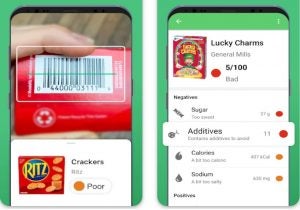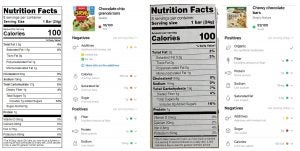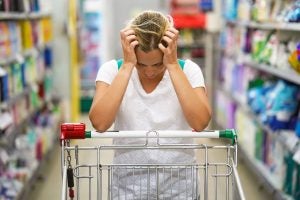[ad_1]
So there’s a trend on TikTok where persons are downloading an application that tells you if your foods is very good or undesirable — they progress to scan all the things in their household and then end up throwing absent a bunch of meals and skincare products and solutions because the app told them it is all poor and unhealthy.
There are numerous versions of apps like this that level foods and/or skincare merchandise making use of some kind of score technique, ordinarily colors and/or a 1-100 score or a little something identical. All the person has to do is scan the barcode of a product and voilà, the app spits out some kind of rating and all of a sudden you consider that all the things in your residence is harmful and seeking to eliminate you.
So, what is the offer with these apps? Are they proof dependent? What is powering the scores and are they exact?
The application that I’ve been observing most just lately is named Yuka. You down load the cost-free app, scan a products, and it spits out a dark environmentally friendly (fantastic), mild environmentally friendly (good), orange (lousy), or crimson (negative) designation for the products alongside with a rating from 1-100. It also shows the additives in the solution together with their ratings as perfectly. The additive ratings are as follows: green (no hazard), orange (moderate threat), yellow (constrained danger), or purple (hazardous).

Correct away, I noticed that the ranking designations for the additives never make any scientific perception. Inexperienced seemingly implies “no chance,” but there is chance that will come with basically all the things we take in. Even h2o can present a risk at a big ample dose. Then we have orange, which is reasonable hazard, yellow, which is minimal danger, and red, which is dangerous. This also doesn’t make perception since the calculation to establish chance is hazard situations publicity. In buy to know the threat that some thing poses, the publicity, or dose, is important. Even so, the application doesn’t base these ratings off of a dose, so there’d be no way to even comprehend possibility without the need of that data.
You can quickly see how this scale isn’t scientific at all. So how can risk even be calculated for these additives with no giving a dose? The response is that it simply cannot!
I made a decision to attempt it out and scanned a box of Chewy Chocolate Chip Granola Bars, and no shock, they are rated 16/100 and crimson “bad.” They have three additives that are “limited risk” (calcium carbonate, sorbitol, and glycerol) and two that are “no risk” (tocopherol and lecithin). So, why the rationale for these kinds of a bad score? Well, it rated the calories orange mainly because it is “a little bit as well caloric” at 100 energy for each bar, “a little bit way too fatty” at 1.5g of saturated extra fat for each bar and “a bit far too sweet” at 7g of sugar per bar. For whom? Which is always the concern I question with these apps.
A 100 calorie granola bar that helps make up a smaller section of an in general well balanced food plan is not “bad” as this application sales opportunities you to believe that. Yet, we have folks actually throwing out their meals because this application explained to them it’s poor. It’s definitely bonkers.
What is even far more bonkers is the solutions that it endorses for you rather — and this is where the attractiveness to nature fallacy arrives in, which is what these scores are largely primarily based on. So, for this particular item, a single of the proposed solutions that it gave me as an alternative of the Chewy Chocolate Chip Granola Bars had been the Only Nature Chewy Chocolate Bars. These acquired a whopping 52/100 with a green “good” designation. That’s more than 3 situations the score that the Chewy granola bars received.
So, what’s the variance? 1st off, they are organic, of class. The app presents it a green check out simply because organic suggests “no artificial herbicides.” Organic and natural can make up 10 percent of the over-all score on this application. This, irrespective of the truth that natural does not necessarily mean safer than artificial and also even with the reality that there is now very a bit of facts demonstrating that natural meals is no a lot more wholesome that typical. When once more, this is nothing but the appeal to mother nature fallacy. The “limited risk” additives provide the rating down on the Chewy bars as nicely even however they are very protected additives, particularly at the very low amounts in this merchandise.
The largest variations concerning the two goods is that the Chewy bars have 1.5g far more extra fat for every bar and the Simply Character bars have 1g more sugar per bar. The simple fact that this results in these types of a big change in the over-all rating is ridiculous. This is just 1 of quite a few examples I could exhibit to illustrate how utterly worthless this app, and many other individuals like it definitely are. I also locate it intriguing how they checklist the “negatives” initially for the Chewy bars and the “positives” very first for the Simply just Mother nature bars. Looks very biased, doesn’t it?

One more illustration I tackled in a video clip was from an individual who scanned their pita bread and then threw it absent just after getting out this application gave it a 48/100 “poor” ranking. The application mentioned that it is made up of “additives to avoid” and rated one of the additives as “hazardous.” The score plan does not allow for a products to get more than 49 if any additive is deemed “hazardous,” so that is fundamentally the full explanation this solution receives a “poor” score.
Effectively, what is the “hazardous” additive? Disodium diphosphate, and this is a perfect case in point of how these apps don’t just take dose into account in any way. This was presented a “hazardous” designation because surplus phosphorous in the food plan can be damaging, but extra of any vitamin or mineral can be damaging, so with this reasoning, anything could be deemed dangerous. If we truly choose dose into account, we can deduce from the diet panel and ingredient declaration that there is no extra than 100mg of phosphorous for every serving of pita bread. The advised each day total of phosphorous for an grownup with out kidney problems is 700mg to 1200mg for each working day. So, in a person serving of pita bread, there is only 10 to 15 percent of the proposed day by day quantity of phosphorous.
There is phosphorous in a natural way current in numerous diverse foods. For instance, a 3-ounce piece of salmon is likely to have any place from 200mg to 300mg of phosphorous. A 1-ounce part of Romano cheese contains about 200mg of phosphorous, but of course these apps would in no way get in touch with salmon or cheese “hazardous” thanks to the phosphorous content. The tolerable higher consumption of phosphorous for a nutritious adult is 4000mg per working day. You’d get that volume from having 40 parts of this pita bread day-to-day.

You can clearly see from these illustrations how the fact that these applications really don’t acquire dose into account and weighting in favor of “natural” and “organic” when those people designations explain to you almost nothing about the basic safety or nourishment of a food stuff, rendering these ratings ineffective. Not to point out that everybody has unique dietary requirements, and dietary demands can fluctuate for the exact same particular person day to day.
At greatest, these apps are just wildly inaccurate, biased, and nonsensical. At worst, they can be very destructive not only due to the fact that they’re producing individuals to toss out flawlessly protected foods, but also resulting in pointless anxiety about harmless food items and additives, which can direct to disordered feeding on behaviors. Far more obtainable, less highly-priced foods get rated decrease than related variations of items that are additional high priced and significantly less obtainable. These applications are just one more way to demonize a lot more obtainable foods, which triggers the most hurt to people are now struggling with food items insecurity.
Diet is way way too nuanced and specific for a colour-coded score scale to be exact.
Ultimate verdict: Do by yourself a favor and delete these types of foods apps for your very own sanity and perfectly getting.
Foods Science Babe is the pseudonym of an agvocate and writer who focuses precisely on the science behind our food items. She has a diploma in chemical engineering and has labored in the foodstuff marketplace for a lot more than decade, both in the regular and in the all-natural/organic and natural sectors.
[ad_2]
Supply url

